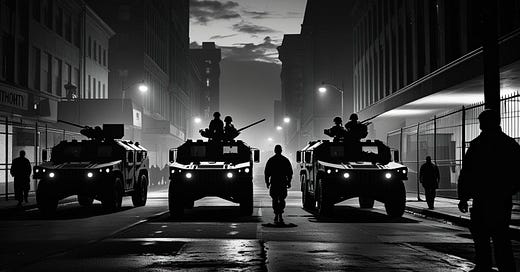The Military Blueprint for Controlling American Cities That Never Really Ended
It was October 1967, and Detroit still smoldered. While America watched footage of soldiers patrolling American streets, Pentagon planners were taking notes. Not on what went wrong—but on how to do it better next time.
Within months, they had a name for their new project: Operation Garden Plot. Because apparently, someone thought planning military occupation of American cities deserved a name that sounded like a community gardening initiative.
This wasn't a contingency plan gathering dust in some forgotten filing cabinet. This was an active, evolving blueprint for deploying the United States military against its own citizens. A blueprint that, disturbingly, reads less like history and more like today's headlines.
The Architecture of Domestic Military Control
Operation Garden Plot emerged from a simple premise: civil unrest in America had become complex enough to require military solutions. The year 1968 saw riots following Martin Luther King Jr.'s assassination, massive anti-war protests, and cities burning from Newark to Washington.
The government's response? Create a standardized playbook for military deployment on American soil.
The plan was breathtakingly comprehensive. It detailed:
Which military units to deploy for specific scenarios
Command structures that bypassed normal civilian oversight
Intelligence gathering protocols for American citizens
Detention procedures for mass arrests
Coordination frameworks between military and civilian law enforcement
This wasn't theoretical. Garden Plot created the administrative infrastructure for martial law—complete with forms, procedures, and training programs. They literally bureaucratized the suspension of civil liberties.
When Theory Became Practice
Garden Plot wasn't an academic exercise. Throughout its official existence, the military activated these protocols repeatedly:
The 1992 Los Angeles Riots saw the deployment of 10,000 National Guard troops and 3,500 federal troops. Garden Plot's procedures guided everything from initial deployment to rules of engagement. Soldiers patrolled American streets using tactics refined through decades of planning.
Hurricane Hugo (1989) provided cover for testing Garden Plot's coordination mechanisms. While ostensibly providing disaster relief, military units practiced urban control techniques and civilian population management.
The 1971 May Day Protests witnessed the largest mass arrests in U.S. history—over 12,000 people detained. Garden Plot's detention protocols proved so "efficient" that they overwhelmed the court system. Most arrests were later ruled unconstitutional, but the procedures remained in place.
Each activation served as a real-world training exercise, refining the machinery of domestic military deployment.
The Technical Precision of Democratic Erosion
What made Garden Plot particularly insidious was its bureaucratic banality. This wasn't a dramatic coup plot—it was administrative preparation for authoritarian control.
The planners created standardized forms for requesting military intervention. They established "liaison protocols" that sounds benign but effectively merged military and civilian law enforcement. They developed "intelligence sharing agreements" that turned soldiers into domestic spies.
Most chilling? They created legal frameworks that made the unconstitutional appear routine. Suspending posse comitatus—the law preventing military from acting as domestic police—became a matter of checking the right boxes on the right forms.
REX 84: When Garden Plot Got Steroids
In 1984, Garden Plot spawned an even more ambitious offspring: REX 84 (Readiness Exercise 1984). This exercise simulated rounding up 400,000 "refugees"—but the infrastructure it tested could handle any population deemed problematic.
REX 84 revealed Garden Plot's true scope:
Suspension of the Constitution under various scenarios
Detention camps for American citizens
Military tribunals replacing civilian courts
Censorship and communication blackouts
Oliver North, of Iran-Contra fame, helped design these exercises. When questioned during Congressional hearings, the topic was deemed too sensitive for public discussion. Democracy, apparently, couldn't handle the truth about its own contingency plans.
The Infrastructure That Survived
Officially, Operation Garden Plot ended in the 1990s, replaced by newer directives with friendlier names. But here's the thing about infrastructure—physical or administrative—once built, it rarely disappears.
The fusion centers monitoring American citizens? Garden Plot architecture. The military equipment flowing to police departments? Garden Plot legacy. The joint training exercises between soldiers and cops? Garden Plot methodology. The normalization of military responses to civilian issues? Pure Garden Plot.
Today's Garden: Marines in LA, National Guard in Florida
Fast forward to 2025. Marines and National Guard deployed to Los Angeles. The National Guard deployed to Florida for "crime prevention." Each deployment follows patterns established by Garden Plot—vague missions, indefinite timelines, gradual normalization.
They don't call it Garden Plot anymore. Now it's "civil support operations" or "domestic security assistance." The names changed; the playbook didn't.
The Marines and National Guard deployments were normalizing military presence in civilian spaces—exactly as Garden Plot intended. The operation succeeded not by preventing crime, but by making armed soldiers in American cities seem routine.
Florida's National Guard deployment represents Garden Plot's evolution. Deployed for "crime prevention"—not response, prevention—they've made military solutions to civilian problems standard operating procedure. The infrastructure Garden Plot built makes this feel normal, even necessary.
The Pattern We Can't Unsee
After decades of refinement, the Garden Plot template follows a predictable pattern:
Identify the Crisis: Crime statistics, civil unrest, natural disasters—any justification works
Deploy Military Assets: Always with reassuring language about "supporting" civilian authorities
Expand the Mission: Scope creep isn't accidental; it's architectural
Normalize the Presence: Make withdrawal politically impossible ("You want to remove safety measures?")
Institutionalize the Deployment: Create precedent for next time
Each cycle makes the next deployment easier, the public resistance weaker, the constitutional concerns quieter.
The Quiet Death of Posse Comitatus
The Posse Comitatus Act of 1878 was supposed to prevent what Garden Plot perfected—using the military as domestic law enforcement. But Garden Plot's genius was creating exceptions that swallowed the rule.
Through careful bureaucratic erosion:
"Supporting" civilian authorities became active policing
"Temporary" deployments became indefinite presence
"Emergency" responses became routine operations
"Limited" missions became expansive mandates
Garden Plot didn't repeal Posse Comitatus. It made it irrelevant through procedure.
Why This Matters Right Now
Every military deployment on American soil strengthens precedent. Every normalized presence makes the next one easier. Every bureaucratic innovation in "civil-military cooperation" adds another brick to Garden Plot's foundation.
We're not sliding toward militarized law enforcement—we've arrived. Garden Plot drew the blueprint; we're living in the building.
The genius of Garden Plot wasn't planning for martial law—it was making martial law unnecessary by normalizing military control through administrative means. Why suspend the Constitution when you can achieve the same effect through proper procedures?
The Documents Tell the Story
Declassified Garden Plot documents read like dystopian fiction. Meetings where officials discussed "population control measures." Memos about "detention facilities for civil disturbances." Training manuals for "cordon and search operations" in American cities.
They documented everything because they saw nothing wrong with it. In their minds, they were protecting democracy by planning its suspension. They were preserving freedom by preparing to eliminate it. The cognitive dissonance would be funny if it weren't so terrifying.
The Harvest of the Garden
They called it Garden Plot because they were planting seeds. Today, we're living in their harvest:
Military units trained for domestic deployment
Legal frameworks enabling constitutional suspension
Public acceptance of soldiers as law enforcement
Infrastructure treating citizens as potential enemies
The seeds sprouted exactly as planned. The garden grew. And most Americans don't even realize they're living in it.
The Call to Recognition
Next time you see military vehicles on American streets, remember this isn't an emergency response. It's a well-rehearsed performance following a script written in 1968.
When politicians deploy troops for "public safety," they're not innovating—they're implementing. When military units patrol civilian spaces, they're not adapting—they're executing decades-old plans.
Operation Garden Plot succeeded beyond its planners' wildest dreams. Not by preventing unrest, but by making military control feel normal, necessary, even comforting to some.
The Verdict
In the end, Garden Plot represents the moment American democracy began eating itself. When military solutions to civilian problems became standard procedure. When constitutional protections became administrative obstacles. When "emergency" became permanent.
The infrastructure remains. The procedures persist. The mindset endures.
They planned for war against their own citizens with the same methodical precision used for foreign invasions. They filed it properly. Trained for it regularly. Refined it constantly.
And they bet—correctly—that we'd be too distracted, too divided, or too defeated to notice when they started implementing it.
Welcome to the garden. It's been growing for 57 years.
Sources:
U.S. Department of Defense, "DOD Civil Disturbance Plan (Garden Plot)," 1968 (Declassified)
Senate Subcommittee on Constitutional Rights, "Military Surveillance of Civilian Politics," 1973
General Accounting Office, "Military Assistance in Civil Disturbances," 1992
Rex 84 Documentation, Iran-Contra Hearings, 1987
U.S. Army Field Manual 19-15, "Civil Disturbances," 1985
FOIA releases on Garden Plot operations, National Security Archive






